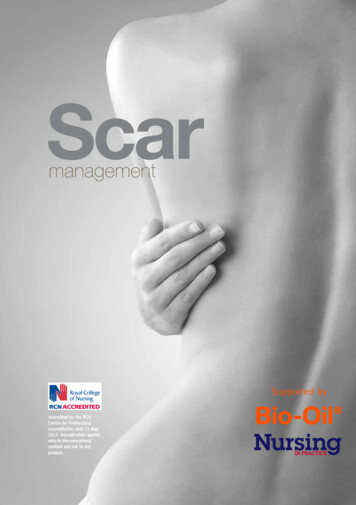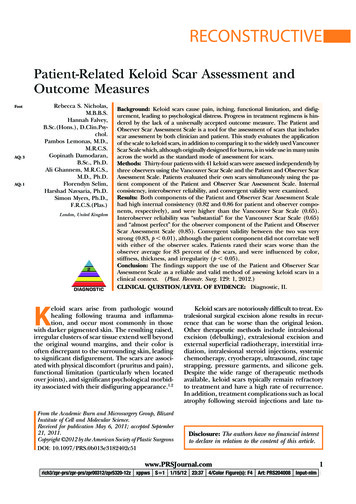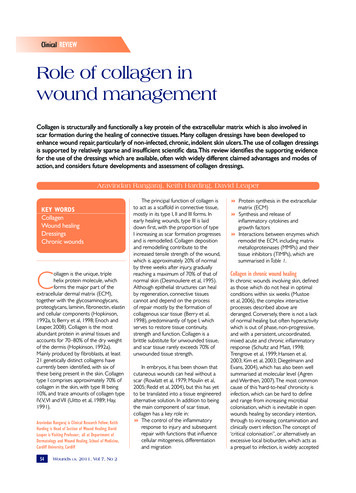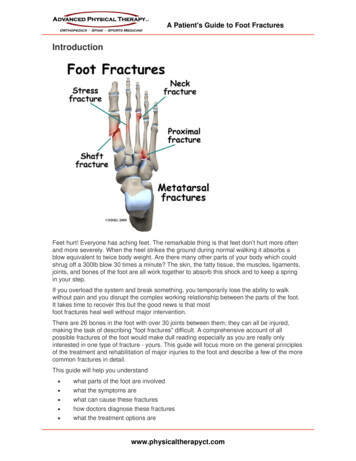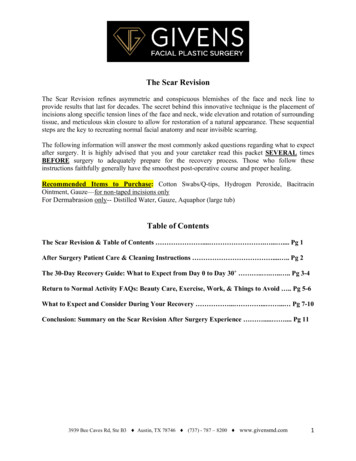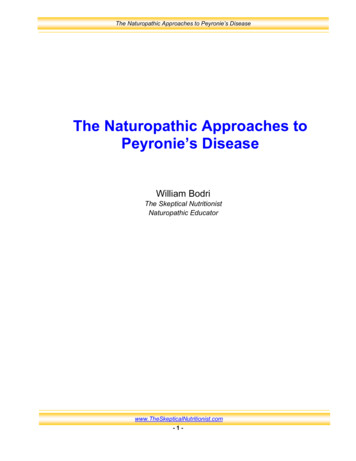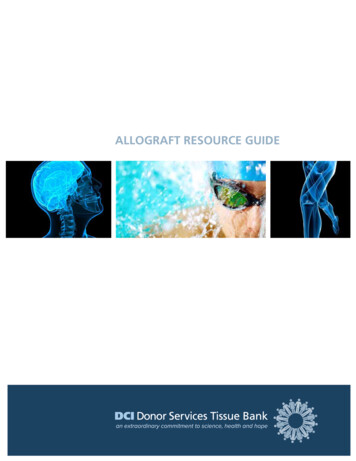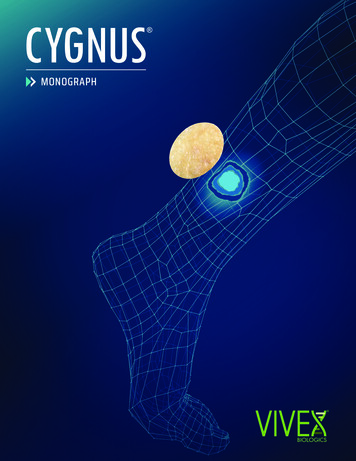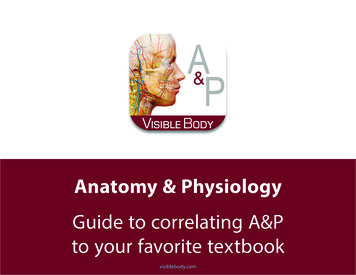
Transcription
ABMP Scar Tissue Management: Part 1-IntroductionSCAR TISSUE MANAGEMENT SERIESSCAR TISSUEMANAGEMENTPart 1: Introductionwith Nancy Keeney Smithand Cathy Ryan1Part 1Part 2Part 3IntroductionClinical Considerations MT role in scar tissuemanagement EdemaAssessment and TreatmentGuidelines Techniques:Lymphatic system Assessment and evaluation Fascia and connective tissue Stages of wound healing Lymphatic system Fibrosis Wound healing:Normal and abnormal Techniques:Fascia and connective tissue Treatment protocols:Lymphatic system Treatment protocols:Fascia and connective tissue2SCAR TISSUECourse OutlineWhat is the issue?MANAGEMENT❶ Introduction❷ MT role in scar tissue managementPart 1: IntroductionWhat needs to change?❸ Fascia and connective tissue❹ Lymphatic systemHow can our hands facilitate the needed changes?❺ Wound healing and scar formation:Normal and abnormal34Course Outline❶ IntroductionRichard Lebert, RMT❷ MT role in scar tissue managementThe RMT Education Project❸ Fascia and connective tissuewww.rmtedu.com❹ Lymphatic systemSCAR TISSUEMANAGEMENTPart 1: Introduction❺ Wound healing and scar formation:Normal and abnormal5 2020, Associated Bodywork & Massage Professionals61
ABMP Scar Tissue Management: Part 1-IntroductionSLIDING NETWORKLOOSE CTFascia and Connective Tissue (CT)Dense and LooseFiber and FluidGC Guimberteau – Interior Architecture, Handspring 2015Fluid-filled space observableonly in living/hydrated tissue78SLIDING NETWORKLOOSE CT Capable of viscosity changes Volume and viscosity have arole in: Reducing friction Creating space (fluid gap)between articulating tissuesand structures SlidingABGC Guimberteau – Interior Architecture, Handspring 2015Organization and distribution of intramuscular connective tissue in normal and immobilized sketchmuscles. Jarvinen, T et. Al, V(2002). Journal of Muscle Research and Cell Motility 23: 245-254Fluid-filled space observableonly in living/hydrated tissue910Superficial Fascia Provides a passageway forlarger nerves, blood,and lymphatic vesselsDeep Fascia Creates muscle containers(epi, peri, endomysium)www.handspringpublishing.com Comprises dense and looseconnective tissueFrom “Scar Tissue Management,” Smith & Ryan 2016, Handspring Publishing11 2020, Associated Bodywork & Massage Professionals122
ABMP Scar Tissue Management: Part 1-IntroductionSCAR TISSUECourse OutlineInflammationMANAGEMENT❶ Introduction❷ MT role in scar tissue managementPart 1: Introduction The lymph system plays a vital role in inflammationmanagement. Lymphatic dysfunction may contribute tothe development of pathophysiological scars.❸ Fascia and connective tissue❹ Lymphatic system Excess swelling/edema creates a tensional pull on tissue.Increased mechanical tension drives collagen deposition.❺ Wound healing and scar formation:Normal and abnormal1314Lymph System DiscoveriesLymph Nodes University of Virginiadiscovery of lymph vesselsin the brain1,000 plus nodesOne-way systemCleanses fluidCollects information15Glymphatic system60% active while we sleep16Lymphatics and Cancer BiologyDr. Melody SwartzConference2015 Joint Conference on Acupuncture, Oncology, andFasciaPresentationLymphatics and Cancer Biology Lymph fluid is rich with informationPresenterMelody A. Swartz, PhDWilliam B. Ogden Professor, Institute of MolecularEngineering, University of Chicago, Illinois The lymph system is hardy Inflammation issues are showing signsof autoimmune issues (research coming)Video ?v 01bGsu3H4Y8&t 499s17 2020, Associated Bodywork & Massage Professionals183
ABMP Scar Tissue Management: Part 1-IntroductionLymphatic LoadsTwo Aspects of theLymphatic Vessel SystemWhat the system carries Surface Structures96% waterProteinsCellsFat (only in digestive system)Deep StructuresFluids, Fascia, and The Lymphatic System - An Ortho-Bionomy Approach - Liz Olivas, BFA, MT, CLT1920EsophagusLeft lymphatic ductTracheaRight lymphatic ductTheLymphaticSystemRight subclavian veinLeft subclavian veinRight venous angleThoracic DuctLeft venous angle2AortaAzygos veinThoracicduct(thoracicportion) Originates anterior tovertebrae T1 - L2 Runs upward to connectwith the left venous angleDiaphragmHemiazgos veinCisterna chyliRight lumbar trunkFrom “Scar Tissue Management,” Smith & Ryan 2016, Handspring Publishing21 Behind the left clavicle, itconnects to theleft subclavian vein andinternal jugular veinLeft lumbar trunkFrom “Scar Tissue Management,” Smith & Ryan 2016, Handspring Publishing22Unhealthy SystemImportant Role of the Lymphatic System inTraumatic Scar Wound Healing Four continuous minutes of abdominal lymph pumping(1 pump/sec) has been shown to increase immune cell release frommesenteric lymph nodes. Specialized T cells primed in the gut are faster-acting/superiorperforming immune cells.A dysfunctional lymphatic system cannot remove product that is collecting in thetissues at a rate that keeps the tissues properly cleansed. Recent studies suggest that abdominal lymphatic pumping mayinhibit solid tumor development and bacterial pneumonia.This interferes with the homeostasis of the tissues.23 2020, Associated Bodywork & Massage Professionals(Hodge et al. 2010, 2013)244
ABMP Scar Tissue Management: Part 1-IntroductionConference2015 Joint Conference on Acupuncture, Oncology, andFasciaManual Therapy and LymphaticsDr. Lisa HodgePresentationManual Therapy and Lymphatics 5–7 minutes of abdominal pumping gets the systemmovingPresenterLisa Hodge, PhDAssociate Professor, Department of Cell Biology andImmunology, University of North Texas Health ScienceCenter, Texas This action initiates the lymph-immune systemVideo ?v MFMk76jdjxM&t 127s2526Course OutlineSCAR TISSUE❶ IntroductionMANAGEMENT❷ MT role in scar tissue managementWound Healing and Scar FormationPart 1: IntroductionPhysiological (Normal)❸ Fascia and connective tissueand❹ Lymphatic systemPathological (Abnormal)❺ Wound healing and scar formation:Normal and abnormal2728Normal Stages of Wound HealingNormal Stages of Wound HealingHomeostasis Clot formation to control bleedingRemodelingLasts from months to yearsProliferationTypically lasts 4–21 days (may last up to 6 weeks)Starts within 48-72 hours of initial injuryInflammation Immune cells clean the area Various cells begin the process of healingInflammationLasts 1–4 daysProliferation Scar forms to heal the wound gap and restore tissue integrity(may last weeks)HomeostasisImmediateDays5101520Remodeling Stronger scar material (collagen) is produced to increase the strength of thehealed tissue and restore function25Several factors can influence and impact the process.29 2020, Associated Bodywork & Massage Professionals305
ABMP Scar Tissue Management: Part 1-IntroductionPrimary Players in Skin and Connective Tissue/FasciaRemodeling and Collagen Production Fibroblasts MyofibroblastsAbnormal Wound HealingCan be influenced by When collagen proliferation does not shut down,abnormal scars will form. Stress/anxiety Sympathetic nervous system/parasympatheticnervous system imbalance Neural hyperactivity or sensitization Transforming GrowthFactor: TGF-ß1 The physical hallmark of pathological scars isexcessive/anomalous (fibrotic) collagen. Excess or prolonged inflammation/edema Immobilization Tissue tension31 If (hyper) vascular/neural regression does not occur, thescar and surrounding tissue function may be abnormal.32Abnormal Wound HealingAbnormal Wound HealingWhen collagen proliferation does not shut down, abnormal scars will form.Hypertrophic scar: abnormal scar withinthe wound margins (raised, pigmented)Keloid scar: abnormal collagen extendsbeyond the margin of the woundFrom “Traumatic Scar Tissue Management,” Smith & Ryan 2016, Handspring Publishing3334FibrosisFibrotic collagen: Fuzzy/rough, lacking normal crimp, dense, brittle, rigid,pathological cross-links, and disorganized/chaotic arrangementWound healing doesn’t alwaysresult in fibrosis.So what happens?Healthy tissuespacious and well organizedWound areaHow do we get there?dense and chaoticAdapted from: Coelho, N. M., & McCulloch, C. A. (2016). Contribution of collagen adhesion receptors to tissue fibrosis. Cell and tissue research, 365(3), 521-538.35 2020, Associated Bodywork & Massage Professionals366
ABMP Scar Tissue Management: Part 1-IntroductionPrimary Drivers of Profibrotic ActivityInflammationPrimary Drivers of Profibrotic ActivityExcessive/prolonged inflammation Mediated by infection/ineffective cleanup, persistentpresence of pro-inflammatory and sensitizing agents(smoking, deficient nutrition, rubbing/friction, stress/anxiety,immobilization, subsequent reinjury, and anomalous tissuetension).TissuetensionPremature/anomalous tissue tension Mediated by myofibroblast overactivity, excess/prolongededema, excess extrinsic tension,sympathetic/parasympathetic nervous system imbalance,neural hyperactivity.Excessive/prolonged inflammationPremature/anomalous tissue tension3738Research StudyManual therapy as an effective treatment for fibrosis in a rat model of upper extremity overuse injuryResearchers: Geoffrey M. Bove, Michele Y. Harris, Huaqing Zhao, Mary F. BarbePublished in Journal of the Neurological Sciences, www.jns-journal.comTensionMyofascial-type therapy (MT) was performed bilaterally 5xs/week, for 10 minutes during 12 weeks of hard training. Appropriate intrinsic tension (physiological wound contraction) isnecessary for wound closure.The untreated group (no MT) displayed key overuse presentations:Pain-related behavioral changes (pain expression, guarding/protecting, movement reluctance, decreased strength)Fibrotic neural, muscular, and connective tissue/fascial changes. Classic collagen fibrotic changes: hyper-proliferation,incoherent organization, rigid, fuzzy/rough (dermis, subcutaneous tissue/superficial fascia, tendon, fascial coverings[epi, peri, endo], neural ECM) Scar formation/closure/remodeling is also influenced by extrinsictensional forces.The MT-treated group’s neural, muscular, and connective tissue/fascial tissue showed diminished fibroticchanges. Excessive extrinsic forces can accelerate angiogenesis, neurogenesis,cell proliferation, and collagen hyperproduction.The MT attenuated changes appear to be related to tissue and serum levels of TGF-ß1.Thus, MT, applied in the early stages of symptom development, may be an effective preventative for: Decreasing excessive/anomalous collagen Pain-related behavioral changes and consequent nerve compression pathology and conduction velocity changesOgawa et al. (2011)3940Nancy Keeney Smithntouchtherapy@aol.comFacebook: NTouch Therapy LLC Profuse, prolonged inflammationTissue tensionNeural distress or heightened activityImmobilizationCathy .handspringpublishing.com41 2020, Associated Bodywork & Massage Professionals427
ABMP Scar Tissue Management: Part 1-IntroductionScar Tissue Management SeriesReference ListScar Tissue Management SeriesReference ListBenjamin, M., Kaiser, E., & Milz, S. (2008). Structure‐function relationships in tendons: a review. Journal of Anatomy, 212(3), 211-228.Cowman, M. K., Schmidt, T. A., Raghavan, P., & Stecco, A. (2015). Viscoelastic properties of hyaluronan in physiological conditions. F1000Research, 4.Berrueta, L., Muskaj, I., Olenich, S., Butler, T., Badger, G. J., Colas, R. A., . & Langevin, H. M. (2016). Stretching impacts inflammation resolution in connectivetissue. Journal of Cellular Physiology, 231(7), 1621-1627.Crane, J. D., Ogborn, D. I., Cupido, C., Melov, S., Hubbard, A., Bourgeois, J. M., & Tarnopolsky, M. A. (2012). Massage therapy attenuates inflammatory signalingafter exercise-induced muscle damage. Science Translational Medicine, 4(119), 119ra13-119ra13.Bialosky, J. E., Beneciuk, J. M., Bishop, M. D., Coronado, R. A., Penza, C. W., Simon, C. B., & George, S. Z. (2018). Unraveling the mechanisms of manual therapy:modeling an approach. Journal of Orthopaedic & Sports Physical Therapy, 48(1), 8-18.Franchi, M., Ottani, V., Stagni, R., & Ruggeri, A. (2010). Tendon and ligament fibrillar crimps give rise to left‐handed helices of collagen fibrils in both planar andhelical crimps. Journal of Anatomy, 216(3), 301-309.Bishop, M. D., Torres-Cueco, R., Gay, C. W., Lluch-Girbés, E., Beneciuk, J. M., & Bialosky, J. E. (2015). What effect can manual therapy have on a patient's painexperience?. Pain Management, 5(6), 455-464.Fritz, S. (2016). Mosby's Fundamentals of Therapeutic Massage. Elsevier Health Sciences.Bouffard, N. A., Cutroneo, K. R., Badger, G. J., White, S. L., Buttolph, T. R., Ehrlich, H. P., . & Langevin, H. M. (2008). Tissue stretch decreases soluble TGF‐β1 andtype‐1 procollagen in mouse subcutaneous connective tissue: Evidence from ex vivo and in vivo models. Journal of Cellular Physiology, 214(2), 389-395.Fryer G, Fossum C (2009) Therapeutic mechanisms underlying muscle energy approaches. Physical therapy for tension type and cervicogenic headache: physicalexamination, muscle and joint management, Boston: Jones and BartlettGracovetsky, S. (2016). Can fascia’s characteristics be influenced by manual therapy? Journal of Bodywork and Movement Therapies, 20:893–897Bouffard N et al 2009 Tissue stretch decreases procollagen-1 and TGF-β1 in mouse subcutaneous fascia. Abstract. 2nd Fascia Research Congress. Free University ofAmsterdam, Amsterdam.Guimberteau, J. C., & Delage, J. P. (2012, October). The multifibrillar network of the tendon sliding system. In Annales de chirurgie plastique et esthetique (Vol. 57,No. 5, pp. 467-481).Bove, G., & Chapelle, S. (2012). Visceral mobilization can lyse and prevent peritoneal adhesions in a rat model. Journal of Bodywork and Movement Therapies.Guimberteau (2012) Scars and Adhesions Panel – Lecture notes from The 3rd International Fascia Research Congress, Vancouver, 28-30 MarchChaitow (2014) Fascial dysfunction – manual therapy approaches. Pencaitland, UK: Handspring Publishing.Chaitow, L. (Ed.) (2018). Fascial dysfunction – manual therapy approaches. 2nd Ed. Handspring Publishing.Hodge LM, Bearden MK, Schander A et al (2010) Abdominal lymphatic pump treatment mobilizes leukocytes from the gastrointestinal associated lymphoid tissueinto lymph. Lymphatic Research and Biology 8: 103-10.Corey, S. M., Vizzard, M. A., Bouffard, N. A., Badger, G. J., & Langevin, H. M. (2012). Stretching of the back improves gait, mechanical sensitivity and connectivetissue inflammation in a rodent model. PloS one, 7(1), e29831.Hodge LM, Bearden MK, Schander A et al (2013) Lymphatic pump treatment mobilizes leukocytes from the gut associated lymphoid tissue into lymph. LymphaticResearch and Biology 8(2): 103-110.4344Scar Tissue Management SeriesReference ListScar Tissue Management SeriesReference ListHicks, M. R., Cao, T. V., Campbell, D. H., & Standley, P. R. (2012). Mechanical strain applied to human fibroblasts differentially regulates skeletal myoblastdifferentiation. Journal of Applied Physiology, 113(3), 465-472.Pohl, H. (2010). Changes in the structure of collagen distribution in the skin caused by a manual technique. Journal of bodywork and movement therapies, 14(1),27-34.Huang, C., Holfeld, J., Schaden, W., Orgill, D., & Ogawa, R. (2013). Mechanotherapy: revisitingphysical therapy and recruiting mechanobiology for a new era in medicine. Trends in Molecular Medicine, 19(9), 555-564.Roman, M., Chaudhry, H., Bukiet, B., Stecco, A., & Findley, T. W. (2013). Mathematical analysis of the flow of hyaluronic acid around fascia during manual therapymotions. The Journal of the American Osteopathic Association, 113(8), 600-610.Kanazawa, Y., Nomura, J., Yoshimoto, S., Suzuki, T., Kita, K., Suzuki, N., & Ichinose, M. (2009). Cyclical cell stretching of skin-derived fibroblasts downregulatesconnective tissue growth factor (CTGF) production. Connective Tissue Research, 50(5), 323-329.Schleip R, Muller DG (2013) Training principles for fascial connective tissues: Scientific foundation and suggested practical applications. Journal of Bodywork andMovement Therapies, 17(1): 103-115Khan, K.M. and Scott, A. (2009) Mechanotherapy: how physical therapists’ prescription of exercise promotes tissue repair. British Journal of Sports Medicine 43,247–252Simmonds, N., Miller, P., & Gemmell, H. (2012). A theoretical framework for the role of fascia in manual therapy. Journal of Bodywork and Movement Therapies,16(1), 83-93.Kisseleva, T., Cong, M., Paik, Y., Scholten, D., Jiang, C., Benner, C., . & Evans, S. M. (2012). Myofibroblasts revert to an inactive phenotype during regression of liverfibrosis. Proceedings of the National Academy of Sciences, 109(24), 9448-9453.Smith, N. & Ryan, C. (2016). Traumatic Scar Tissue Management – Massage Therapy Principles, Practice and Protocols. Pencaitland, UK: Handspring Publishing.Langevin, H. M. (2013). The science of stretch. The Scientist, 27(5), 32.Langevin HM, Nedergaard M, Howe AK (2013) Cellular control of connective tissue matrix tension. Journal of Cellular Biochemistry, 114(8): 1714-9.Matteini, P., Dei, L., Carretti, E., Volpi, N., Goti, A., & Pini, R. (2009). Structural behavior of highly concentrated hyaluronan. Biomacromolecules, 10(6), 1516-1522.Stecco, C., Fede, C., Macchi, V., Porzionato, A., Petrelli, L., Biz, C., . & De Caro, R. (2018). The fasciacytes: a new cell devoted to fascial gliding regulation. ClinicalAnatomy, 31(5), 667-676.Thompson, W. R., Scott, A., Loghmani, M. T., Ward, S. R., & Warden, S. J. (2016). Understanding mechanobiology: physical therapists as a force in mechanotherapyand musculoskeletal regenerative rehabilitation. Physical Therapy, 96(4), 560-569.Threlkeld, A. J. (1992). The effects of manual therapy on connective tissue. Physical Therapy, 72(12), 893-902.Ng, J. L., Kersh, M. E., Kilbreath, S., & Knothe Tate, M. (2017). Establishing the basis for mechanobiology-based physical therapy protocols to potentiate cellularhealing and tissue regeneration. Frontiers in Physiology, 8, 303.Tortora, G.J., Funke, B.R., Case, C.L. (2007). Introduction to Microbiology. San Francisco: Pearson Benjamin Cummings.Ogawa, R. (2011). Mechanobiology of scarring. Wound Repair and Regeneration, 19, s2-s9.Tozzi, P., 2012. Selected fascial aspects of osteopathic practice. Journal of Bodywork and Movement Therapies, 16(4), 503e519.4546Scar Tissue Management SeriesReference ListTroeger, J. S., Mederacke, I., Gwak, G. Y., Dapito, D. H., Mu, X., Hsu, C. C., . & Schwabe, R. F. (2012). Deactivation of hepatic stellate cells during liver fibrosisresolution in mice. Gastroenterology, 143(4), 1073-1083.Waters-Banker, C., Dupont-Versteegden, E. E., Kitzman, P. H., & Butterfield, T. A. (2014). Investigating the mechanisms of massage efficacy: the role of mechanicalimmunomodulation. Journal of Athletic Training, 49(2), 266-273.Wynn, T. A. (2007). Common and unique mechanisms regulate fibrosis in various fibroproliferative diseases. The Journal of Clinical Investigation, 117(3), 524-529.Zuther JE (2011) Lymphedema management: the comprehensive guide for practitioners, 2e. Stuttgart: Thieme47 2020, Associated Bodywork & Massage Professionals8
ABMP Scar Tissue Management: Part 1-Introduction 2020, Associated Bodywork & Massage Professionals 1 SCAR TISSUE MANAGEMENT Part 1: Introduction with Nancy Keeney Smith and Cathy Ryan SCAR TISSUE MANAGEMENTSERIES Part1 Part 2 Part 3 Clinical Considerations Edema Techniques: Lymphatic system Fibrosis Techniques: Fascia and connective tissue
